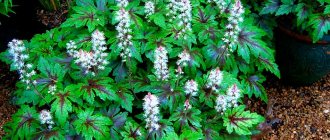Brief description of annual phloxes
Phlox is a herbaceous plant from the Sinyukhov family. They are very diverse, but annuals are represented by only one species - Drummond phlox, which has many varieties that differ in appearance and coloring of flowers. These phloxes are also found in the wild, sometimes reaching considerable heights. In general, annual phloxes grow in height to no more than 25–30 cm. The stem is usually straight, with small oval-lanceolate-shaped leaves located on it in pairs (opposite). The flowers have a diameter of no more than 3 cm, collected in complex corymbose or umbrella-shaped inflorescences, each of which can contain almost a hundred flowers.
Annual phloxes are named after their discoverer, the Englishman Henry Drummond, who “relocated” the plant from America to European countries. The remarkable thing is that this unpretentious flower can bloom all summer, from June until frost. With its help, they decorate territories by planting phlox as borders, on alpine hills, together with other flowers or separately. Phlox are all-weather: they are not afraid of light frosts and scorching sun, they tolerate droughts and partial shade. Every year they can be sown in a new place without fear of problems with germination and flowering.
Description of the species
Phlox is a herbaceous plant of the Cynuaceae family. The genus includes about 85 species, and only half of them are grown as garden crops. The bushes are decorated with bright flowers that have a pleasant aroma. Most species are perennials, only Drummond's phlox is an annual. It is native to the southwestern United States and is distributed in North America and Europe.
The stems of annual phlox are thin, erect and branched. Plants reach a height of 60 cm. Subshrub varieties grow up to 150 cm in the sun. The leaves are rich green, entire, oval-lanceolate in shape. On the shoot they are placed opposite.
Annual phlox flowers are white, red, purple, pink, blue, beige, etc. In some varieties they are monochromatic, while in others they have a dark center. The petal shape can be needle-shaped or round. Varieties with double and semi-double flowers have been bred. Their diameter is 2-4 cm. The buds are collected in corymbose inflorescences, several dozen in each. Phlox Drummond exudes a strong aroma. Flowering begins in June and continues until frost. The seeds ripen in an oval-shaped fruit-box.
The following varieties of annual phlox are distinguished:
- Star-shaped. It is distinguished by brightly colored dissected petals. The shape of the flower resembles a star with an eye. Phlox reaches 30 cm in height, and low-growing forms - up to 12 cm.
- Large-flowered. The buds are large in size and varied in color. The stems are erect, up to 30 cm long. The varieties “Tall Fire Red” and “Tall White” look impressive.
On a note! Among the variety of colors, annual phloxes of pastel or salmon color are most often found.
Reproduction of annual phlox
You can plant annual phlox in the ground either with seeds or with pre-grown seedlings. The choice depends on the preferences of the grower: phlox planted from seedlings will bloom earlier, but the labor costs for this method are much higher. In any case, the seeds of annual phlox are not scarce; they are very easy to collect in your flowerbed; do this at the end of summer. Other methods, besides seed, have no application: although cuttings are theoretically possible, it has no practical meaning.
If you want to grow annual phlox seedlings, proceed in the usual way, known to all gardeners. Seed preparation can begin as early as March, then the first flowers can be seen at the end of May. The process of growing seedlings is as follows.
- Drainage (2 cm of small pebbles or coarse sand) and universal soil for flowers are placed in any suitable containers (boxes, pots, containers) with a height of 8 cm. Water the soil.
- It is advisable to soak the seeds in water for several hours and then dry them until they flow.
Phlox seeds are not small at all
- The seeds are sown superficially (you can only press them lightly into the soil), after which they are sprayed with water from a spray bottle and covered with glass.
- In a warm (about 23 ° C) bright place, seedlings appear in 7–10 days, after which the glass is removed.
- After two weeks, the seedlings are planted so that there is at least 8-10 cm between them. They are kept at room temperature, but for the first week - preferably about 15 oC, with enough light (window sill). Care: moderate watering.
Sometimes seedlings bloom already in pots
Seedlings are planted in open ground in May, in warm soil.
Disease and pest control
Most often, annual phloxes are affected by the following diseases:
- Phomasis;
- septoria;
- variegation;
- powdery mildew;
- verticillium.
To prevent fungal infection, plants are irrigated with colloidal sulfur. Affected phloxes are treated with Bordeaux mixture twice with an interval of 15 days. Bushes with signs of powdery mildew and variegation are immediately dug up and burned to prevent the spread of the disease.
Phlox Drummond bushes are often damaged by pests:
Nematode
The bushes are burned and the soil is treated with nematicides, such as Carbation or Tiazone, 3 times every 20 days.
Naked slugs
An unfavorable condition for their habitat is regular loosening of the soil. The soil around the plantings is dusted with wood ash or tobacco dust.
How to plant low-growing phlox in open ground
If you grew seedlings, with the onset of relative warmth (not like for tomatoes: phloxes are not afraid of even slight frosts) they are planted in a flowerbed without deepening, at a distance of 20–25 cm between the bushes. However, fewer and fewer flower growers are practicing this approach, preferring direct sowing of seeds in open ground.
When to plant annual phlox in open ground
Sowing phlox seeds in a flower bed can be done quite early: the soil should warm up to about 10 °C. In the middle zone this is the first half of May.
Pre-winter sowing is also possible: it is carried out shortly before the onset of real frost.
Many inexperienced gardeners get upset when seeds do not germinate and think that they sowed them at the wrong time. The fact is that the seeds of annual phlox are quite large, so they are often sown “out of habit” deep. However, in fact, the seeds, although large, germinate with difficulty: they are covered with a voluminous, dense shell, which must become wet in order to germinate. Phlox should be sown almost superficially, but ensuring good soil moisture.
Preparing for landing
Phlox can grow almost anywhere, but one must take into account the need for frequent watering, especially before emergence and at the beginning of plant development. The place should be flat, preferably sunny (slight partial shade is not a problem). It is better if the shade covers the flowers during the hottest time of the day. Protection from cold winds is required only in harsh climatic regions.
The soil can be of any composition, preferably with neutral acidity, breathable, and moisture-absorbing. In the fall, it is dug up with the usual doses of organic and mineral fertilizers (per 1 m2 - a bucket of humus, a handful of ash, 30–40 g of nitrophoska). A few days before sowing, the flowerbed is watered abundantly. The seeds can be sown dry, but you can pre-soak them in water for several hours and dry them slightly.
Instructions for planting in open ground
Planting of finished seedlings is carried out in small holes, having first spilled them well with water. Seedlings should be removed from containers with a lump of earth to make it easier to position the roots: otherwise, establishment will be longer. The planted bushes are well watered and shaded for several days.
It is especially important to carefully remove the seedlings if they are still weak.
Sowing phlox seeds is usually carried out in furrows. They should be very shallow: burying seeds deeper than 0.5 cm is not recommended. The distance between the grooves is about 30 cm. 2-3 seeds are placed in them every 15–20 cm, lightly pressed into the soil, sprayed with water from a spray bottle or very carefully watered from a small watering can. You can mulch the crops with a thin layer of straw, but you still need to spray the flowerbed with water every 2-3 days. In about two weeks, shoots will appear; after another week, the weakest ones can be removed.
Phlox varieties Drummond
The most common varieties of Drummond phlox are:
- "Star Rain". The flowers resemble stars and come in two colors. The bushes reach a height of 50 cm. They tolerate drought and light frosts well.
- "Chanel". Compact bushes are covered with double, yellow-red inflorescences.
- "Shimmering Star" The bushes are low-growing, up to 25 cm high. The flowers are large with pointed petals.
- "Promise pink." The variety is distinguished by large, double flowers. They have a rich pink color and a pleasant aroma. The height of the shoots is only 20 cm.
- "Constellation". The diameter of the flower is 3 cm. The shades of the petals are varied. The bushes are lush and branched.
- Low-growing varieties include phlox "Shamoa" (pink), "Snow Globe" (white), "Isabella" (yellow), "Salmon" (salmon) and "Defiance" (red). Due to the compactness of the bushes, they are often grown on balconies and verandas.
On a note! Annual phloxes are sensitive to light: in the sun the flowers become bright, but in the shade or on a cloudy day their color fades.
Caring for annual phlox
After the seedlings emerge and begin to grow, caring for phlox is very simple. They will grow on their own, but for lush flowering it is necessary to carry out basic measures.
Features of watering and fertilizing
At first, phloxes have to be carefully watered 2-3 times a week; for adult plants, weekly watering is sufficient (in the absence of rain, up to two buckets of water are consumed per 1 m2). The water should be settled, not too cold, preferably rainwater. The best time is evening, watering is carried out at the root. In dry times, you need to water more often: if the soil dries out, phlox will grow, but bloom very weakly. After watering and rains, the soil is loosened shallowly. Mulching with any bulk material makes maintenance easier.
For luxurious flowering of phloxes, they are fed several times during the summer. You can use any fertilizer: at the end of spring, mullein infusion is optimal; in June, any potassium salt is added to it. In mid-summer, organic fertilizing is carried out again, and in August you can limit yourself to full mineral fertilizer.
The easiest way is to take fertilizer specifically for flowers.
Formation of plants
Phlox can be grown without forming bushes, but in order for them to branch better, it is worth pinching in time. Both with and without seedling cultivation, this is done at approximately 4 weeks of age, when the top is trimmed with fingernails or scissors. For intensively growing bushes, the procedure can be repeated later, especially in the case of relatively tall varieties.
After the inflorescences wither, they should be carefully trimmed to continue flowering and maintain decorativeness. After the end of the season, you can try to carefully cut the stems almost to the ground: it happens that, despite their annual nature, some plants overwinter and continue to grow and bloom in the spring. True, this requires a warm winter and luck.
When and how to collect seeds
Most varieties of annual phlox bloom until the end of summer, and often extend into September. By this time, if the inflorescences are not cut off, seed pods appear from them. You should not hope that bushes left in winter will continue to grow: it is safer to sow phlox annually.
Self-seeding is also possible: in some regions, annual phloxes are capable of scattering seeds in the fall and easily sprout in the spring and produce new plants.
Collecting the seeds is not difficult. To do this, as the shoots with seeds turn yellow, they are carefully cut off and stored in the room where the seeds ripen. The capsules crack and the seeds are collected from them. You can let them ripen on the bushes, but it is difficult to decide on the time of collection: many of the seeds will fall out on the ground. However, you don’t need a lot of them: you can easily collect the required number of seeds in August-September. Store them in paper or linen bags in a dry place.
The seeds are in boxes
Plant transplantation
It is usually not necessary to replant annual phloxes, but if the need arises, this can be done with a large lump of earth almost at any time. However, during the period of intense flowering it may slow down, so the operation must be carried out especially carefully. After transplanting, it is important to water the bushes well and preferably shade them for a couple of days.
Problem solving
Annual phlox rarely causes problems. But sometimes they don’t bloom. This may be due to:
- lack of lighting;
- poor soil quality;
- insufficient watering.
All these reasons can be eliminated, except when plants are planted in direct shade. It is not difficult to arrange watering and fertilize.
It happens that the leaves on phlox dry out and fly off ahead of time. Drought is usually to blame, and if the plants are not completely dead, watering can bring them back to life. Sometimes during periods of intensive growth the stems may crack. Most often this is due to increased nitrogen content in the soil; You can try urgently adding ash fertilizer.
Video: growing phlox through seedlings
Transplanting phloxes to a permanent place
Annual phloxes prefer sunny areas with fertile soil. They feel best in partial shade. These flowers should not be planted in places where water stagnates. Drummond Phlox is suitable for light, non-clayey soil with a slightly acidic or neutral reaction. Compost and coarse sand are added to heavy soil. The planting site has been prepared since the fall. The soil is dug up and rotted manure is added. Lime acidic soil.
Before planting, phlox seedlings are watered abundantly. The holes are dug at a distance of at least 20 cm from each other, water is poured into each and 150 g of ash is added. The seedling is placed in a hole, the roots are sprinkled with earth and carefully compacted. Plantings are watered with warm water. Then the tree trunk surface is sprinkled with dry soil. During the first two weeks, seedlings are watered every 2 days, and in hot weather - daily.
Important! To make the bushes lush, you need to pinch the main shoot above 5-6 leaves. This procedure promotes the formation of lateral stems.











